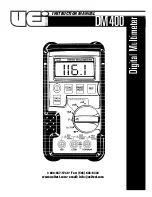
are connected in either direction to the diode, the diode is probably
shorted.
Note:
The reading displayed on the LCD is not an accurate indication of the
voltage drop of the device or circuit being measured.
7.7 Temperature
Test:
WARNING!
Do not apply voltage or current to the meter when it is set to the
Temperature measurement mode.
Do not attempt to measure the temperature of an electrically "live" surface.
User injury may result.
The provided thermocouple is only intended to measure temperatures
up to 300 degrees F. Exceeding this temperature may damage the probe.
7.7.1
Connect the black lead of thermocouple probe to the
COM
jack and
the red lead of thermocouple probe to the
V/
Ω
/mA / F
jack.
7.7.2
Set the RANGE switch to the degree
F
range.
7.7.3
Press the tip of the thermocouple probe against the surface to be
measured. The tip may also be immersed in non-corrosive liquids.
7.8 Transistor
Gain
Test:
7.8.1
Set the RANGE switch to the
hFE
position.
7.8.2
Insert the transistor whose gain is to be measured into the test socket.
Observe the correct polarity (NPN vs PNP) and pinout (E (Emitter), B
(Base), C (Collector).
Notes:
1) The Transistor Gain Test does not indicate if a transistor is "good" or "bad".
It only tests for gain assuming that the transistor is good.
2) For safety purposes, the contacts in the test socket are recessed down into the
socket. This may cause difficulty when attempting to measure the gain of
transistors removed from a circuit board. To test transistors with short leads,
solder a small length of solid wire to each lead before inserting into test socket.
18
Содержание 1101-A
Страница 1: ...TRIPLETT MODEL 1101 A 1...
Страница 24: ...24...







































